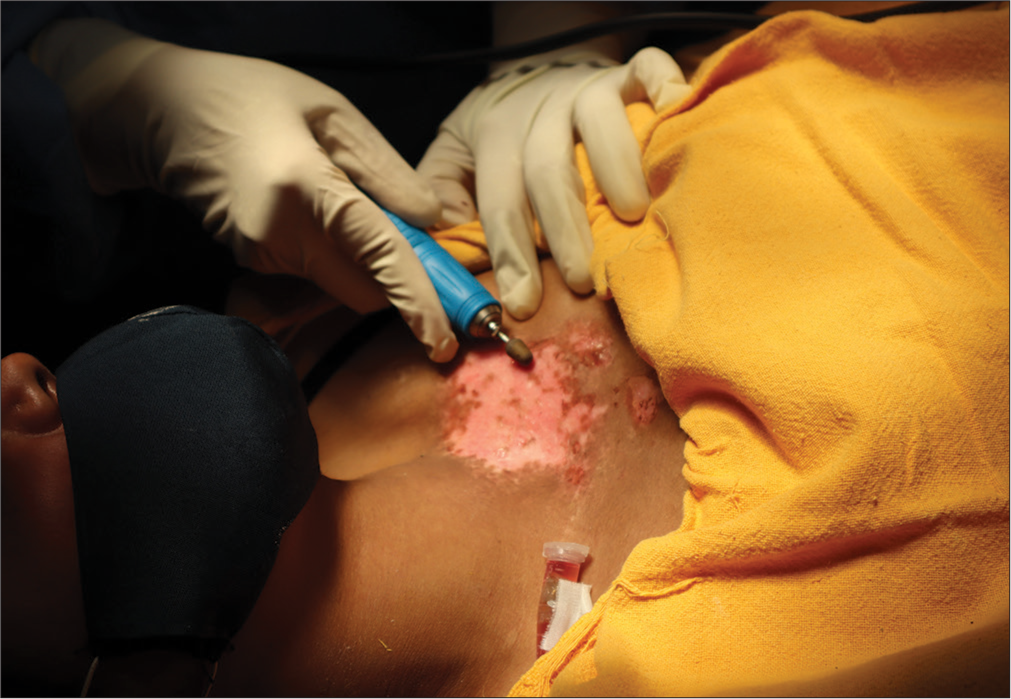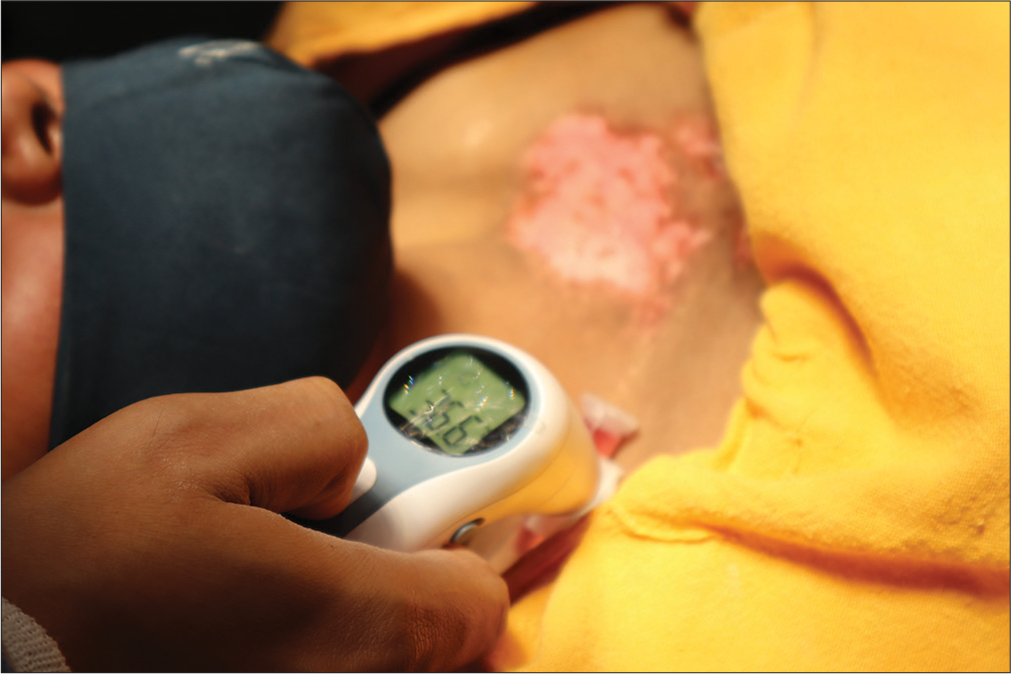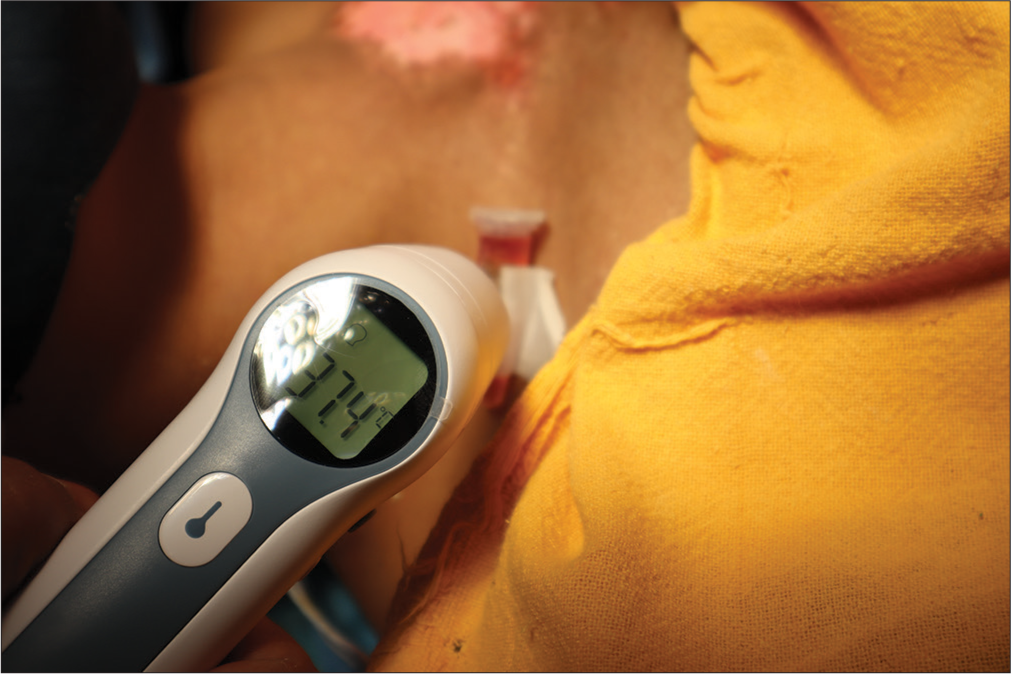Translate this page into:
Heat from operation theater light as a replacement for incubator in cellular grafting techniques for vitiligo

*Corresponding author: Nikhil Mehta, Department of Dermatology and Venereology, All India Institute of Medical Sciences, Delhi, India. nikhilmehtadermatology@gmail.com
-
Received: ,
Accepted: ,
How to cite this article: Sahni K, Dev T, Gupta S, Mehta N. Heat from operation theater light as a replacement for incubator in cellular grafting techniques for vitiligo. CosmoDerma. 2023;3:184. doi: 10.25259/CSDM_226_2023
PROBLEM
In cellular grafting techniques for stable vitiligo, including non-cultured epidermal cell suspension (NCES), the harvested graft needs to be trypsinized to facilitate cell separation.[1] Trypsinization is classically done at 37℃ for 30–120 min using an incubator. Incubator machines are costly, occupy large space in the operating room, and do not serve any purpose in other dermatosurgical procedures. Any malfunction in the machine can halt the whole procedure of NCES. A reasonable alternative is required to the incubators.
SOLUTION
After harvesting, the skin graft is transferred into an Eppendorf tube containing the trypsinethylenediaminetetraacetic acid solution which is fixed with micropore tape to the skin surrounding the surgical site under the illumination of the operation theater (OT) light [Figure 1]. While the surgeon dermabrades the vitiligo lesions, the graft incubates in the trypsin solution under the OT light [Figure 2]. In contrast with incandescent bulbs and compact florescent lamps which lose 80–90% energy as heat, with only 10–20% being utilized as light, light emitting diode (LED) lights lose only 20–50% energy as heat, with a significant part converted to light.[2,3] This wastage occurs at the junction of LED lights with the fixtures. A substantial amount of heat can be generated when multiple LED lights are grouped together or if they have an inefficient heat sink.[4] This wastage can be utilized as a heat source during vitiligo surgeries. We had this idea when a few patients complained of excessive heat sensation over the OT light-exposed surface during prolonged surgeries, and even the operating surgeons felt the same. We have observed that with a room temperature of 21–25℃, the skin surface temperature, without illumination, ranges from 30℃ to 35℃. This rises to 37℃ within a few minutes of being under the field of the OT light, even with the “cold” LED lamps [Figures 3 and 4]. This is later maintained in the optimum range for the trypsin to act on the graft allowing epidermal separation within the next 45–60 min.

- Heat from operation theater (OT) light as an alternative to incubator in cellular grafting techniques for vitiligo. Fixation of Eppendorf tube with graft and trypsin-ethylenediaminetetraacetic acid to skin of the patient in the field of OT light using tape.

- The procedure is continued while the Eppendorf tube with the graft is taped to the nearby skin.

- Gradual increase in the skin temperature of the patients after few minutes under the field of operation theater lights, when the room temperature is 21–25℃.

- A skin temperature of 37℃ is achieved in a few minutes under the field of operation theater lights when the room temperature is 21–25℃.
This innovation enables the use of the commonly available OT light instead of a costly space-occupying incubator. It does not require the lights to stay on separately as the surgeon can continue with the procedure in the same field. Although cold trypsinization over 18 h may yield better results,[5] the prolonged waiting period creates inconvenience for both patient and surgeon. Although axillary incubation has also been proposed as an alternative, it requires the patient to maintain a somewhat uncomfortable position for a long time. This innovation allows dermatosurgeons in low-resource settings to undertake this gratifying cellular transplantation procedure with minimum investment and without inconvenience to patient. Using heat from the OT light in combination with the body heat, the temperature of 37℃ can be achieved without an incubator. This novel use of OT light saves money, time, and space. It will motivate dermatosurgeons in low-resource settings to perform cell-based surgeries for vitiligo.
Ethical approval
Institutional Review Board approval is not required.
Declaration of patient consent
The authors certify that they have obtained all appropriate patient consent.
Financial support and sponsorship
Nil.
Conflicts of interest
There are no conflicts of interest.
Use of artificial intelligence (AI)-assisted technology for manuscript preparation
The authors confirm that there was no use of artificial intelligence (AI)-assisted technology for assisting in the writing or editing of the manuscript and no images were manipulated using AI.
References
- Leucoderma treated by transplantation of a basal cell layer enriched suspension. Br J Dermatol. 1998;138:644-8.
- [CrossRef] [PubMed] [Google Scholar]
- Do LED lights get hot?-yes or not, let's uncover the truths [WWW Document] 2023. ElectronicsHub. Available from: https://www.electronicshub.org/led-bulbs-get-hot [Last accessed on 2023 Nov 20]
- [Google Scholar]
- Do LED lights get hot? You might be surprised by the answer [WWW Document] 2022. Homebuilding Renov. Available from: https://www.homebuilding.co.uk/advice/doled-lights-get-hot [Last accessed on 2023 Nov 20]
- [Google Scholar]
- Heat dissipation design and optimization of high-power LED lamps. Therm Sci Eng Prog. 2023;37:101587.
- [CrossRef] [Google Scholar]
- Comparison of efficacy of cold trypsinization versus warm trypsinization in preparation of autologous non-cultured epidermal cell suspension for treatment of stable vitiligo. J Eur Acad Dermatol Venereol. 2019;33:e237-9.
- [CrossRef] [PubMed] [Google Scholar]





